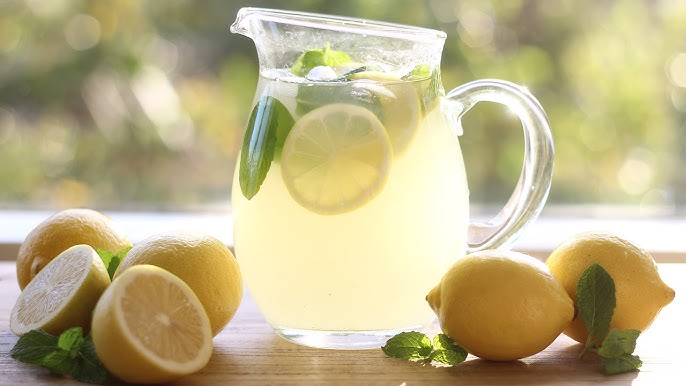Lemonade Recipe: There’s something magical about sipping on a glass of cold lemonade on a hot summer day. With its perfect balance of tartness and sweetness, lemonade isn’t just a drink—it’s a refreshing treat!
Luckily, making lemonade at home is simple and requires only a few ingredients. Plus, you get to control the sweetness and experiment with flavors. Ready to quench your thirst?
Let’s dive right into this step-by-step lemonade recipe!
Ingredients Required for Homemade Lemonade
Here’s a list of the ingredients you’ll need to make the best lemonade from scratch:
- Water – For dilution and making simple syrup.
- Sugar – Traditional white sugar works best, but you can use honey or other sweeteners.
- Fresh Lemons – The star ingredient that brings in the tangy goodness.
- Ice Cubes – Keeps your lemonade chilled and refreshing.
- Optional Garnishes – Mint leaves, basil, or lemon slices to enhance the flavor and presentation.
Choosing the Best Lemons for Maximum Flavor
Always use fresh, ripe lemons with a vibrant yellow color. Avoid lemons with green patches or wrinkles as they tend to be less juicy. Meyer lemons, which are sweeter than regular ones, are a great choice if you want a less tart lemonade.
Tools You’ll Need to Make Lemonade
Having the right tools makes the lemonade-making process much easier. Here’s what you’ll need:
- Juicer – To extract maximum juice from the lemons.
- Strainer – To remove seeds and pulp.
- Pitcher – For mixing and serving.
- Measuring Cups and Spoons – Ensures accurate proportions for the best taste.
Pro Tip: Can You Make Lemonade Without a Juicer?
Absolutely! If you don’t have a juicer, roll the lemons firmly on a countertop to release the juices, then squeeze them manually using your hands or a fork.
How to Make Lemonade – Step by Step Guide
Step 1 – Preparing the Lemons
For the juiciest lemons, start by rolling them on a hard surface using firm pressure. This helps break down the fibers inside, making it easier to extract the juice. Once rolled, slice the lemons in half and squeeze the juice into a bowl, removing seeds as you go. If you like a pulp-free drink, strain the juice through a fine-mesh sieve.
Step 2 – Making the Simple Syrup
Simple syrup is key to achieving a smooth sweetness in your lemonade. Instead of adding plain sugar directly to the drink (which might not dissolve well), prepare a simple syrup:
- Combine 1 cup of sugar and 1 cup of water in a saucepan.
- Heat the mixture on medium heat, stirring until the sugar dissolves completely.
- Once dissolved, remove it from heat and let it cool.
This syrup can be made ahead of time and stored in the fridge. If you prefer healthier options, swap sugar with honey or agave syrup.
Step 3 – Combining the Lemon Juice and Simple Syrup
Once your lemon juice and simple syrup are ready, it’s time to combine them. Start by adding the fresh lemon juice into a large pitcher. Then, pour in the cooled simple syrup, adjusting the quantity based on how sweet or tart you like your lemonade. For a perfect starting point, try using the ratio of 1 cup lemon juice to 1 cup simple syrup. You can always tweak it to match your taste preferences.
Step 4 – Adding Water and Mixing Thoroughly
Dilution is essential for balancing the flavors. Pour 4 to 5 cups of cold water into the pitcher and stir thoroughly. If you prefer a bubbly drink, swap still water with sparkling water for an effervescent twist. Taste the lemonade and adjust by adding more water or simple syrup if needed.
Step 5 – Chilling and Adding Ice Cubes
Refrigerate the lemonade for at least 30 minutes to let the flavors meld together. When serving, add ice cubes to each glass to keep the drink cold without diluting it too much. Pro tip: Freeze some lemonade into ice cubes to prevent the drink from getting watered down as the ice melts!
Optional Add-Ins to Elevate Your Lemonade
Get creative with your lemonade by adding these extra touches:
- Herbs: Add a few sprigs of mint or basil for a refreshing twist.
- Fruits: Muddle strawberries, watermelon, or raspberries to infuse fruity flavors.
- Floral Notes: Lavender or rosewater can give your lemonade a unique aroma.
- Spicy Kick: Try adding a dash of ginger or cayenne for a bold flavor.
Tips for Serving the Perfect Glass of Lemonade
Presentation matters! Serve lemonade in tall glasses with lemon slices on the rim. For an extra flair, rub a little lemon juice on the rim of the glass and dip it in sugar or salt to create a decorative edge.
Storing Leftover Lemonade Properly
Keep any leftover lemonade in an airtight container in the refrigerator. It will stay fresh for 3 to 4 days. Before serving again, give it a quick stir or shake, as ingredients can separate over time.
Common Mistakes to Avoid When Making Lemonade
- Too Tart or Too Sweet: Adjust the sweetness incrementally and taste as you go.
- Bitter Lemonade: Avoid squeezing the white pith from lemons, which adds bitterness.
- Watery Lemonade: Always use the right lemon-to-water ratio to avoid bland flavors.
Health Benefits of Fresh Lemonade
Lemonade isn’t just delicious; it’s good for you too! It keeps you hydrated and provides a healthy dose of vitamin C, which strengthens the immune system. Plus, it helps in digestion and acts as a natural detoxifier.
Fun Variations of Lemonade from Around the World
- Brazilian Lemonade: Uses whole limes blended with condensed milk.
- Italian Limonata: A sparkling lemonade perfect for warm days.
- Indian Nimbu Pani: A salty, spiced lemonade with cumin and black salt.
FAQs about Lemonade Recipe
1. How do I make homemade lemonade?
To make homemade lemonade, you’ll need fresh lemons, sugar, and water. Start by squeezing the lemons to extract the juice, then mix the juice with sugar and water until the sugar dissolves. For added flavor, try infusing it with mint or berries.
2. How much lemon juice is needed for one glass of lemonade?
Typically, 2-3 tablespoons of lemon juice will give your lemonade a bright and tangy taste. You can adjust the amount based on your sweetness preference.
3. Can I use honey instead of sugar?
Yes! Honey is a great natural sweetener and adds a unique flavor. Use it in moderation and stir thoroughly to ensure it mixes well.
4. How can I make lemonade less bitter?
The bitterness usually comes from the lemon peels. Avoid squeezing the lemon rinds too much, or strain the juice before adding it to the water. Adding more sweetener also balances the tartness.
5. Can I store lemonade?
Absolutely! Store it in the fridge in a sealed container for up to 3-4 days. Stir before serving as the ingredients may settle.
6. How do I make flavored lemonade?
You can create delicious variations by adding fruit like strawberries, watermelon, or blueberries. For a fizzy twist, use sparkling water instead of still water.
7. What’s the best way to serve lemonade?
Serve lemonade chilled with ice cubes. Garnish with lemon slices or mint leaves for an elegant touch.
8. Can I make lemonade without lemons?
While nothing beats fresh lemon juice, bottled lemon juice can work in a pinch. Alternatively, try lime or a mix of citrus fruits for a different flavor.
Conclusion
Making lemonade from scratch is easy, fun, and satisfying. Whether you keep it classic or add your own twist, homemade lemonade is a perfect treat for any occasion. So grab some lemons, mix up a batch, and enjoy every sip!
References
For further reading and validation of the information provided in this Lemonade Recipe, refer to the following reputable sources:
- AllRecipes – Discover a wide variety of lemonade recipes with tips and tricks to perfect your homemade drink.
- Food Network – Explore refreshing lemonade ideas, from classic recipes to creative fruit-infused variations.
- BBC Good Food – Learn expert techniques to make lemonade that stands out with a balance of sweetness and tanginess.
- Delish – Get inspired by simple yet delicious lemonade recipes suitable for all occasions.
These sources ensure the information provided here is reliable, helping you prepare the perfect lemonade every time!



